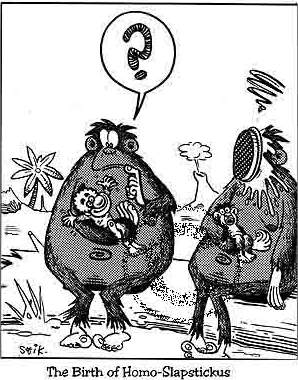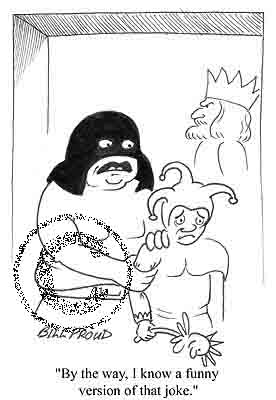

|
Role of Jester Figures and Humour in Providing Social Criticisms Please click a link navigate this section using the page tree below. Upon viewing each page, simply click "Back to top" to return to tree menu.
Historical role of jesters in literature
Above: Artists impression of a medieval jester The
use of jester figures in literary texts has existed for centuries and
dates back to medieval times where such individuals were invited into
the courts of kings to poke fun at social institutions and the ruling
monarchy. Since then, the use of such figures has evolved along with the
styles of drama and literature, as dictated by the social ideologies of
the cultural context in a particular era. However, their fundamental
underlying purpose has largely resisted such changes and they still
remain a dominant feature in modern texts such as Accidental Death Of
An Anarchist and Catch 22. While similarities exist between
the role and purpose of jesters in these two texts, there are of course
many contrasts in the styles and the way humour is employed to create
satires as a basis for broader social criticisms.
Role of jesters in Accidental Death Of An Anarchist
Above: Comical origins of slapstick humour In Accidental Death Of An Anarchist, the Maniac, whose mere title foreshadows his purpose in the play, fulfils the role of the jester figure. He is portrayed prominently by Fo and acts as a zany destabilising force, undermining the attempts of the police to cover-up their corruption. The maniac manages to destabilise reality through his crazy and often outrageously funny ploys, which the reader is able to recognise as being slapstick humour, a type of comedy involving extravagant actions that are ridiculous in their nature. Fo uses this form of farcical drama to heighten the level of uncertainty and thus creates a juxtaposition between sanity and insanity, which is the medium he uses to abruptly hit the reader on the head with the Maniac’s social criticisms.
Purpose of humour in Accidental Death Of An Anarchist The
purpose of these styles of humour can be seen in Act Two, Scene One of
the play when suddenly the Maniac “swallows (his) eye”. What follows
is a period of “craziness” where the characters are seized in
“raptus” and chaos ensures. This is abruptly shattered by the Maniac
when he lets slip in amongst the confusion, a passionate tirade about
the failings of bureaucracy
and the “over-exploitation of workers”
being the fault of society. Thus it is in this manner of periodically
switching between fits of craziness and incisive criticism, that the
jester figure, the Maniac, is able to convey Fo’s social critiques
effectively to the reader.
Role of humour in Catch 22
Above: Example of black humour In
contrast, while Heller’s Catch 22 also makes use of humour to
create social satires, the style he uses to achieve this, appears
slightly different to the techniques employed in Accidental Death Of
An Anarchist. However, on closer examination many parallels can
still be drawn between these works. Like Fo, he wanted his “humour to
make you drop your guard for the serious blow to follow”-Heller, but
instead of using periodic slapstick humour, he indulges in a prodigious
amount of black
humour. This style of wit involves positioning the
reader to adopt a comical approach to disturbing and macabre events, so
that “people laugh and then look back at what they are laughing at and
recoil in horror”-Heller. A well packaged example of this can be seen
in the depiction of the soldier in white, where initially the audience
chuckles at the absurdity of his situation and then are positioned
through Heller’s use of black humour to realise that the soldier in
white is a satire for his criticism about the anonymity of war.
The use of surrealism in Catch 22 Heller at times in the novel also conjures up surrealist images in his humour that are laced with an element of realism, all warped together in a dream-like existence. A prime example of this can be found in the caricature of Colonel Scheisskopf, whose is hyperbolically caught up in nonsensical idiosyncrasies. Heller uses surrealist depictions to ridicule Scheisskopf’s deluded dreams, and thus he becomes a satire for the dehumanising nature of the military bureaucratic system, where obsession with trivial details is more important than human values.
Summary of the role of jester figures to create humour In summary, although both Accidental Death Of An Anarchist and Catch 22 use vastly different styles of humour, they both are ultimately successful in using jester figures and humour to satirise aspects of society for criticism through the creation of a juxtaposition between fits of craziness and incisive criticism.
|


